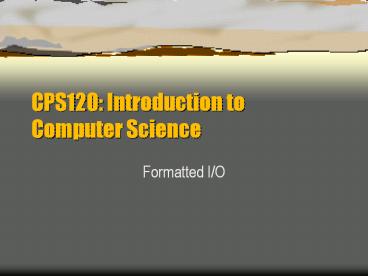CPS120: Introduction to Computer Science - PowerPoint PPT Presentation
1 / 13
Title:
CPS120: Introduction to Computer Science
Description:
CPS120: Introduction to Computer Science Formatted I/O – PowerPoint PPT presentation
Number of Views:56
Avg rating:3.0/5.0
Title: CPS120: Introduction to Computer Science
1
CPS120 Introduction to Computer Science
- Formatted I/O
2
Formatted Output -- Currency
- cout.setf(ios fixed)
- Print fixed point form, not in exponential form
- cout.setf(ios showpoint)
- Says to always print the decimal point
- cout.precison(2)
- Says to print out the two most significant
decimal digits, after rounding to this precision
3
Line Spacing
- In order to end a line in an output statement you
may use the new line character, \n, instead of
endl. - Examples
- cout ltlt "Hello world" ltlt '\n'
- cout ltlt "Hello world" ltlt "\n"
- cout ltlt "Hello world\n"
- These are practically equivalent to
- cout ltlt "Hello world" ltlt endl
4
Escape Sequences
- Other useful "escape sequences" (since the \ is
the escape operator) are - \t to generate a tab
- \\ to print a backslash
- \' to print a single quote
- \" to print a double quote
5
Using setf and unsetf
- Each stream has format options that can be
changed - OPTION DESCRIPTION
- left Left-justifies the output
- right Right-justifies the output
- showpoint Displays decimal point and trailing
zeros for floats - uppercase Displays e in scientific as E
- showpos Displays a leading plus sign
- scientific Displays floating point number
scientifically - fixed Displays floating-point in normal notation
6
Using Format Options
- Format options are set immediately prior to the
COUT statement - float x 24.0
- cout ltlt x ltlt \n // displays 24
- cout.setf(iosshowpoint)
- cout ltlt x ltlt \n // displays 24.00000
- cout.unsetf(iosshowpoint)
- cout ltlt x ltlt \n // displays 24
7
Using Manipulators
- You must include the ltiomanip.hgt header file at
the top of your program in order to use the
setprecision, setw, and other manipulators. You
must use place the following compiler directive
at the top of your program.include ltiomanip.hgt - I/O manipulators are placed directly in the
output statement - cout ltlt setprecision(2) ltlt price ltlt \n
8
Setting Precision
- The setprecision manipulator allows you to limit
the number of digits that are displayed when a
numeric data type is displayed - cout ltlt setprecision(2) ltlt price ltlt '\n'
- only allows the leading two digits of the value
stored in the variable, price, to be displayed
9
More Precisely
- If the fixed format was set previously with the
statement - cout.setf(iosfixed)
- then the setprecision(2) manipulator would have
the effect of rounding or truncating price (and
all future floating-point values in the cout
stream) to the hundredths place
10
Field Width
- The setw manipulator controls the width of the
field when displaying a value. The statement - cout ltlt setw(10) ltlt umEndow ltlt endl
- sets the width of the field allocated for the
variable, umEndow, to 10 characters
11
Formatting Numbers for Output
- double price
- price 78.5
- cout ltlt "The price is "
- cout ltlt price ltlt endl
- We want the price to be 78.50
12
Magic Formula for Currency
- cout.setf(ios fixed)
- cout.setf(ios showpoint)
- cout.precision(2)
13
Formatted Output -- Currency
- cout.setf(ios fixed)
- Print fixed point form, not in exponential form
- cout.setf(ios showpoint)
- Says to always print the decimal point
- cout.precison(2)
- Says to print out the two most significant
decimal digits, after rounding to this precision






























